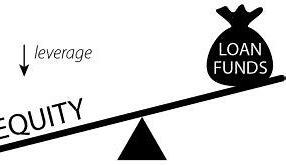
This is a type of loan given to businesses or individuals who already have large debts or bad credit history. Lenders view leverage as a higher risk of default, and therefore leverage is more costly for the borrower. Default is when a borrower cannot make payments for a long time. Leveraged loans for individuals or businesses with debt tend to have higher-interest rates than normal loans. These rates reflect a higher level of risk associated with granting loans.
There are no set rules or criteria to define a leveraged loan. Some market players base it on a spread. For example, many loans pay a variable rate based on the London Interbank Offered Rate (LIBOR) plus a set base or ARM spread. LIBOR is considered a benchmark rate, an average of the rates that global banks loan to each other.
If the ARM margin is more than a certain threshold, it is considered a leveraged loan. Others base the rating on the borrower's credit rating, with loans rated below investment grade, which is rated Ba3, BB- or lower by rating agencies Moody's and S&P.
Understanding Leveraged Loans
A leveraged loan is structured, organized, and managed by at least one commercial or investment bank. These institutions are called arrangers and may then sell the loan, in a process known as syndication, to other banks or investors to reduce creditor risk.
Banks can often change the terms when syndicating the loan, which is called flexible pricing. The ARM margin can be increased if there is insufficient loan demand at the initial interest rate in what is known as upward flex. On the other hand, the spread on LIBOR can be reduced, which is called reverse flex, if the demand for the loan is high.
According to a statement by the Federal Reserve, banks must stop issuing contracts using LIBOR. The Intercontinental Exchange, which is responsible for LIBOR, stopped issuing LIBOR for a week and two months after December 31, 2021. All contracts using LIBOR must be closed by June 30, 2023.
How do businesses use leveraged loans?
Businesses typically use leveraged loans to fund mergers and acquisitions (M&A), balance sheet recapitalization, debt refinancing, or for general business purposes. Mergers and acquisitions can take the form of a leveraged buyout (LBO). A leveraged buyout occurs when a company or private equity firm buys a public entity and takes it private. Debt is generally used to finance part of the purchase price. Balance sheet recapitalization occurs when a company uses the capital market to change the framework of its capital structure. A normal transaction issues debt to buy back shares or pay dividends, which are cash prizes paid to shareholders.
Leveraged loans allow businesses or individuals who already have a history of high debt or bad credit to borrow money but at higher than usual interest rates.
Example of a leveraged loan
S&P Leveraged Commentary & Data (LCD), which provides leverage information and analysis, places a loan in its leverage universe if the loan is rated BB- or lower. Alternatively, an unrated loan or BBB or higher is often classified as a leveraged loan if the spread is equal to LIBOR plus 125 basis points or more and is backed by a first or second lien.
Summary
Leveraged loans are loans given to businesses or individuals who already have large debts or bad credit history.
Lenders consider leveraged loans to have a higher risk of default and are therefore more expensive for borrowers.
Leveraged loans have inflated interest rates than typical loans, reflecting the higher risk associated with issuing loans.
FOR MORE INFORMATION ON HOW KLSM CPA FIRM, PLLC. CAN BEST HELP YOU WITH YOUR TAX FILING NEEDS, PLEASE CLlICK THE BLUE TAB ON THIS PAGE.
THANKS FOR VISITING.
